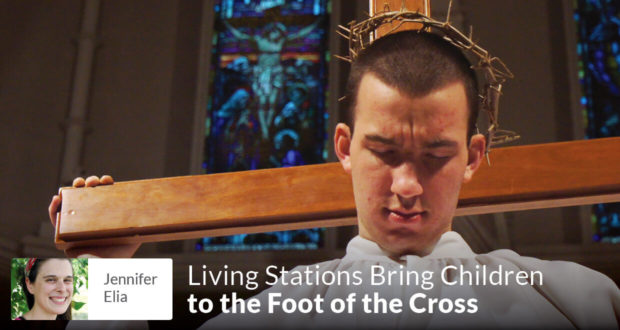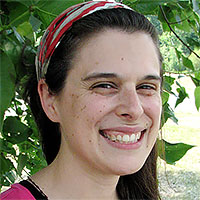Summary
In seven well-described steps, Jennifer Elia shows how to bring a Living Stations program to your parish to let the children live the Stations of the Cross.For the past ten years, our family has participated in our parish’s “Jesus’ Walk of Love.”
My husband and I took over the program eight years ago, and it has become part of our Good Friday tradition. Here is a simple how-to so you can bring this program to your parish and let the children live the Stations of the Cross this Lent.
1. Script
The first, and most important part is to have a script. We use a wonderful one that has been passed down over the years in our parish. If you would like a copy, please comment below, and we will work out a way for you to get one.
The script includes a Narrator part for each station that explains what happened, any lines the actors say, a congregational response for each station, and questions delivered by the priest to get the children thinking about how each station pertains to their lives today. Here is a sample:
Station Four: Jesus meets His mother, Mary
NARRATOR: Here is Jesus, looking into the eyes of his mother, Mary. She must also walk this journey of love. The love of our parents for us is so very great. Do we take the love without giving in return? Do we demand that we have things our way? Just as Mary and Jesus could strengthen each other in such a sad time, we can support our parents with our love. We should give it gladly.
RESPONSE BY ALL: Jesus, please help us to learn to recognize how much our parents love us and give to us. We want to show them how much we care about them.
PRIEST: How do you show love for your parents?
ALL: Pray Hail Mary
SONG: Sing of Mary:”Sing of Jesus, son of Mary, in their home at Nazareth. Toil and labor cannot weary love enduring unto death. Constant was the love he gave her, though He went forth from her side. Forth to preach and heal and suffer, till on Calvary He died.”
2. Costumes
Most of our “costumes” are only costumes in the sense they change the appearance of the actors. We use a lot of tablecloths, pillow cases, old ties, and whatever else we can find. Costumes can be as elaborate or simple as you choose.
For our stations, we have a collection of lengths of fabric in different colors and patterns that are simply folded in half with a head hole cut along the seam. Every time I open the box, I wonder how we will look with such a rag-tag collection of clothes, but every year, once the children are costumed and placed throughout the church, those simple costumes work wonderfully.
Make sure to have something specific for Mary, Jesus, Pilate, and the Roman guards. These costumes, again, can be something simple like a couple of yards of fabric with a head hole, just make sure they are obviously costumes for each part.
So, Mary is in blue, Jesus is in white, Pilate is in purple, etc. In addition to robes, we have head scarves and belts (i.e rectangular scraps of fabric and twine or ribbon for belts).
3. Props
Now, you need to find some props. Props are very important, but remember, they do not need to be elaborate. Here a list of what you need:
crown of thorns/grapevine wreath
- parchment colored scroll for Pilate (we put his lines on the scroll)
- a royal looking large piece of fabric to be draped over Jesus and then “stripped”
- swords and chest plates for guards
- Veronica’s veil (a large piece of white fabric with an image of Jesus’ face on the underside.)
- a cross for Jesus to carry (ours is 6 feet long)
- hammers
- boards with nails partially hammered in
- various dice
- a cross for the crucifixion scene (shorter to accommodate the height of the children)
- two four foot 1 x 3″ boards with ropes tied around each end. (These are used for the two criminals; they slip their hands through the ropes, so it looks like they are also on crosses)
- two cinder blocks (to prop up cross)
- a white sheet to use as the shroud
We use the dice, hammers, and boards with nails to provide “sound effects” but also to get the children involved in a hands-on way. At the tenth station, the dice are rolled to reenact the gambling for Christ’s garment. At the eleventh station, children hammer the nails to provide sound for the actors who are pretending to hammer Christ to the cross.
4. Get the pastor involved
At each station, as mentioned above, we have a reflection read by one of our priests. Some priests simply read the reflection, while others add their own commentary. I think the most important part is having a priest involved in the process.
Also, after our stations, our pastor offers a communion service and veneration of the cross. This is a very special touch that adds so much to the experience. It becomes a true time of worship, instead of being seen as just a school play.
I am always so appreciative of the priests and deacons who take the time during the busiest liturgical week of the year, to minister to the children and families to lead them closer to Jesus.
5. Music
There is not much music included because it is Good Friday, but it is still an integral part. The songs that we have in our script include Were You There, Sing of Mary, Lord, Let Me Walk, and Jesus, Come to Us. After the stations, we have a Veneration of the Cross and Communion Service. Both of these need music. We have replayed some of the above pieces, or covered with just instrumental music.
Don’t forget to organize musicians. We try our hardest to have children do this part as well. I recruit the musicians about a month in advance; but, the more time, the better. Some years we have had one girl play piano for all of the pieces.
This year we have a pianist, a flutist, and a violinist, playing various pieces. It is nice to have a cantor, but it is not necessary. One year, we had five girls volunteer at the last minute. Sometimes, we have one, sometimes none. However, in the end, it all works out.
6. Practice
Plan a practice a few days before your event. Allow for a least a couple of hours to organize everyone, plan costumes, read through the script, decide where each station will be, and teach the children the program.
We always do our practice on Holy Tuesday evening, since nothing is going on at our parish that evening. It also gives the children a few days to study their scripts before performing in front of everyone.
Then on the day of the stations, have a full run through with musicians, props, your priest, and altar boys, if they are helping. We have one altar boy carry a candle in front of Jesus as we process.
In years when we had many children involved, we have had an additional altar boy or Roman guard walking behind the procession to keep it moving forward. At each station, the participant (Mary, Veronica, etc.) follows behind the cross until the end.
7. Open it up to all
The stations are open to any children in pre-k and up who want to participate. However, we also open the walk itself up to any children in attendance that day. So, the children take the walk with Jesus and see up close what happened during His Passion.
In years gone by, we left boxes of costumes at the door for anyone who wanted to dress up. This was fun but a lot of work for me, as I had to track down all the pieces, fold them, and pack them away.
If you have enough parent volunteers, this could be an additional way to bring the story of Good Friday to life for the children. After all, many hands make light work.
Does your parish celebrate Good Friday in a special way for the children?
Header photo CC Matthew Green| flicker.com

 Seton Magazine Catholic Homeschool Articles, Advice & Resources
Seton Magazine Catholic Homeschool Articles, Advice & Resources

